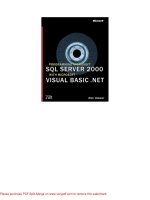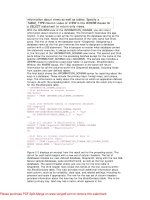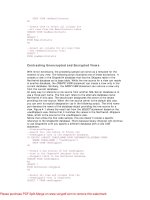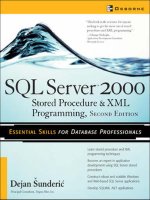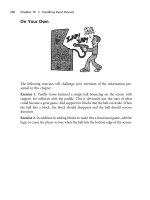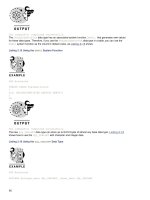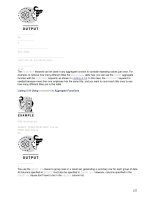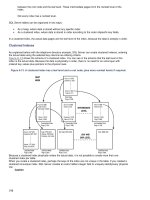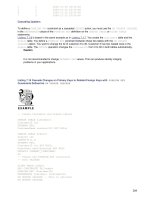SQL Server 2000 Stored Procedure Programming phần 6 ppsx
Bạn đang xem bản rút gọn của tài liệu. Xem và tải ngay bản đầy đủ của tài liệu tại đây (445.82 KB, 76 trang )
Chapter 9: Special Types of Procedures
363
@@IDLE @@TOTAL_READ
@@IO_BUSY @@TOTAL_WRITE
@@MAX_CONNECTIONS GETDATE
@@PACK_RECEIVED NEWID
@@PACK_SENT RAND
@@PACKET_ERRORS TEXTPTR
Notice that GetDate() is also among the forbidden functions.
If you try to use it inside a user-defined function, SQL Server will
report an error as shown in Figure 9-5.
Figure 9-5. A limitation on use of built-in functions in user-defined functions
Encryption
As is the case with stored procedures, functions can be encrypted so
that nobody can see their source code. The developer just needs to
create or alter the function using the With Encryption option.
Schema-Binding
A new option, With Schemabinding, allows developers to
schema-bind a user-defined function to database objects (such as
tables, views, and other used-defined functions) that it references.
Once the function is schema-bound, it is not possible to make schema
changes on underlying objects. All attempts to drop the objects and
all attempts to Alter underlying objects (which would change the
object schema) will fail.
A function can be schema-bound only if all of the following
criteria are satisfied:
▼ All user-defined functions and views referenced by the
function must already be schema-bound.
■ All database objects that the function references must reside
in the same database as the function. References to database
objects cannot have server or database qualifiers. Only object
owner qualifiers and object identifiers are allowed.
▲
The user who executes the Create (or Alter) Function
statement has References permissions on all referenced
database objects.
Table-Valued User-Defined Functions
Since SQL Server 2000 has a table datatype, it is possible to design
a user-defined function that returns a table. The primary use of
table-valued user-defined functions is similar to the use of views.
However, these functions are far more flexible and provide
additional functionality.
You can use a table-valued user-defined function anywhere
you can use a table (or view). In this respect, they implement the
functionality of views, but functions can have parameters and
364
SQL Server 2000 Stored Procedure Programming
therefore they are dynamic. Views are also limited to a single
Select statement. Functions can have one or more Transact-SQL
statements inside and in this way implement more complex
functionality. That is why functions of this type are often referred to
as multi-statement table-valued user-defined functions. Stored procedures
can also return a resultset, but the use of such resultsets is somewhat
limited. For example, only a resultset returned by a function can be
referenced in the From clause of a Select statement.
Let’s demonstrate this functionality. The following Select
statement references the user-defined function fnDueDays, which
returns a list of lease payment due dates. The statement returns a
list of remaining payments and due dates:
select DD.TermId, DD.DueDate, Inventory.Lease
from dbo.fnDueDays('1/1/2000','1/1/2004','monthly') DD, Inventory
where InventoryId = 8
and DD.DueDate > GetDate()
The result will look like this:
TermId DueDate Lease
3 2000-04-01 00:00:00 87.7500
4 2000-05-01 00:00:00 87.7500
5 2000-06-01 00:00:00 87.7500
6 2000-07-01 00:00:00 87.7500
7 2000-08-01 00:00:00 87.7500
Stored procedure prListTerms has functionality similar to the
functionality of the DueDates function. But to perform additional
filtering of the resultset returned by the stored procedure, the developer
would first need to receive the resultset into a temporary table:
Create Table #tbl(TermId int, DueDate smalldatetime)
Insert Into #Tbl(TermId, DueDate)
Exec prListTerms '1/1/2000','1/1/2004','monthly'
Select #tbl.TermId, #tbl.DueDate, Inventory.Lease
Chapter 9: Special Types of Procedures
365
From #tbl, Inventory
Where InventoryId = 8
And #tbl.DueDate > GetDate()
Drop Table #tbl
This is much more complicated than using the comparable function.
Let’s investigate the internals of the fnDueDate function:
Create Function fnDueDays
return list of due days for the leasing
(
@dtsStartDate smalldatetime,
@dtsEndDate smalldatetime,
@chvLeaseFrequency varchar(20)
)
Returns @tblTerms table
(
TermID int,
DueDate smalldatetime
)
As
Begin
Declare @insTermsCount smallint number of intervals
Declare @insTerms smallint number of intervals
calculate number of terms
Select @insTermsCount =
Case @chvLeaseFrequency
When 'monthly'
then DateDIFF(month, @dtsStartDate, @dtsEndDate)
When 'semi-monthly'
then 2 * DateDIFF(month, @dtsStartDate, @dtsEndDate)
When 'bi-weekly'
then DateDIFF(week, @dtsStartDate, @dtsEndDate)/2
When 'weekly'
then DateDIFF(week, @dtsStartDate, @dtsEndDate)
366
SQL Server 2000 Stored Procedure Programming
When 'quarterly'
then DateDIFF(qq, @dtsStartDate, @dtsEndDate)
When 'yearly'
then DateDIFF(y, @dtsStartDate, @dtsEndDate)
End
generate list of due dates
Set @insTerms = 1
While @insTerms <= @insTermsCount
Begin
Insert @tblTerms (TermID, DueDate)
Values (@insTerms, Convert(smalldatetime, CASE
When @chvLeaseFrequency = 'monthly'
then DateADD(month,@insTerms, @dtsStartDate)
When @chvLeaseFrequency = 'semi-monthly'
and @insTerms/2 = Cast(@insTerms as float)/2
then DateADD(month, @insTerms/2, @dtsStartDate)
When @chvLeaseFrequency = 'semi-monthly'
and @insTerms/2 <> Cast(@insTerms as float)/2
then DateADD(dd, 15,
DateADD(month, @insTerms/2, @dtsStartDate))
When @chvLeaseFrequency = 'bi-weekly'
then DateADD(week, @insTerms*2, @dtsStartDate)
When @chvLeaseFrequency = 'weekly'
then DateADD(week, @insTerms, @dtsStartDate)
When @chvLeaseFrequency = 'quarterly'
then DateADD(qq, @insTerms, @dtsStartDate)
When @chvLeaseFrequency = 'yearly'
then DateADD(y, @insTerms, @dtsStartDate)
End , 105))
Select @insTerms = @insTerms + 1
End
Return
End
Chapter 9: Special Types of Procedures
367
368
SQL Server 2000 Stored Procedure Programming
Let me point out to you a few differences between these functions
and scalar functions. User-defined functions that return a table have
a table variable definition in the Returns clause:
Returns @tblTerms table
(
TermID int,
DueDate smalldatetime
)
In the body of the function, there are statements that fill the
contents of the table variable:
Insert @tblTerms (TermID, DueDate)
Values (@insTerms, Convert(smalldatetime, CASE
When @chvLeaseFrequency = 'monthly'
The Return statement at the end of the function does not specify a
value. As soon as it is reached, SQL Server returns the contents of the
table variable to the caller:
Return
End
In-Line Table-Valued User-Defined Functions
An in-line table-valued user-defined function is a special type of
table-valued user-defined function. Its purpose is to implement
parameterized views.
The syntax of an in-line table-valued user-defined function is a bit
different from the syntax of other functions:
Chapter 9: Special Types of Procedures
369
Create Function [owner_name.]function_name
(
[ {@parameter_name scalar_data_type [= default]} [, n] ]
)
Returns Table
[With {Encryption|Schemabinding}[, n] ]
[As]
| Return (select-stmt)
You do not have to define the format of the return value. It is
enough to specify just the table keyword. An in-line table-valued
function does not have the body of a function. A resultset is created
by a single Select statement in the Return clause. It is best to
demonstrate this feature with an example. The following function
returns only a segment of a table based on a role the user belongs
to. The idea is that a manager or any other employee can see only
equipment from his own department:
Create Function fn_DepartmentEquipment
( @chvUserName sysname )
Returns table
As
Return (
Select InventoryId, Make + ' ' + model Model, Location
From Inventory inner join Contact C
On Inventory.OwnerId = C.ContactId
Inner Join Contact Manager
On C.OrgUnitId = Manager.OrgUnitId
Inner Join Equipment
On Inventory.EquipmentId = Equipment.EquipmentId
Inner Join Location
On Inventory.LocationId = Location.LocationId
Where Manager.UserName = @chvUserName
)
Go
370
SQL Server 2000 Stored Procedure Programming
You can use this function in any place where a view or table is
allowed, such as in a Select statement:
Select *
From fn_DepartmentEquipment ('tomj')
Go
Figure 9-6 shows the result of such a statement.
Figure 9-6. Using an in-line table-valued user-defined function
Chapter 9: Special Types of Procedures
371
Managing User-defined Functions in Enterprise Manager
You can access user-defined functions from Enterprise Manager as
shown in Figure 9-7.
If you double-click a function, SQL Server displays a modal form
for editing its properties (that is, code and permissions). This editor is
identical to the editor you use to edit stored procedures (see Figure 9-8).
Figure 9-7. Managing user-defined functions in Enterprise Manager
372
SQL Server 2000 Stored Procedure Programming
If you right-click a function and select New User Defined Function,
SQL Server opens a form with a template for creating a new function
(see Figure 9-9).
Once you have written or changed the function, you can use the
Check Syntax button to verify it, then select OK or Apply to compile
and save it. You can also create and save a function template.
TRIGGERS
Triggers are a unique type of procedure. Triggers are very similar to
events—a type of procedure in certain programming languages such
as Visual Basic. Events in Visual Basic are initiated by the system
when certain actions occur (for instance, a form is loaded, a text box
receives focus, or a key is pressed).
Figure 9-8. Editing user-defined functions
Triggers are associated with a table in a database and executed by
SQL Server when a specific change occurs in the table. The change
could be the result of the following modification statements:
▼
Insert
■
Update
▲
Delete
SQL Server 7.0 and earlier versions recognized only one type of
trigger. In SQL Server 2000, this type is called an after trigger. SQL
Server 2000 introduces a new type—an instead-of trigger. In the
following sections, we first examine the standard (after) triggers
and then we introduce the new instead-of type.
Chapter 9: Special Types of Procedures
373
Figure 9-9. A function template
374
SQL Server 2000 Stored Procedure Programming
Physical Design
Let’s look at the simplified syntax for implementing the core
functionality of triggers:
Create Trigger trigger_name
On table
{For { [Delete] [,] [Insert] [,] [Update] }
As
sql_statement [ n]
As a stored procedure, a trigger logically consists of
▼
A header, which is a Transact-SQL statement for creating a
trigger. It consists of three components:
■
The name of the trigger
■
The name of the table with which the trigger will be
associated
■ A modification statement (that is, an event) that will
initiate the trigger
▲ A body, which contains Transact-SQL statement(s) to be
executed at runtime
In the following example, we first create a new table called
MyEquipment. We populate it with Make and Model information
from the Equipment table, and finally we create a trigger.
The trigger is named trMyEquipment_D and is associated
with the MyEquipment table. It is fired after a Delete statement
is executed against the table. Its function is very simple—it notifies
the user regarding actions and the number of records that have
been deleted.
Create Table MyEquipment
(Id int identity,
Description varchar(50))
GO
populate table
Insert MyEquipment(Description)
Select Make + ' ' + Model from Equipment
GO
Create Trigger trMyEquipment_D
On dbo.MyEquipment
After Delete For Delete
As
Print 'You have just deleted '
+ Cast(@@rowcount as varchar)
+ ' record(s)!'
Go
To execute the trigger, we need to execute the Delete statement:
Delete MyEquipment
Where Id = 2
SQL Server will return the following:
You have just deleted 1 record(s)!
(1 row(s) affected)
You can also execute the Delete statement to delete multiple
records:
Delete MyEquipment
Even in this case, the trigger will not be fired once for each record.
We will receive just one message:
You have just deleted 4 record(s)!
(4 row(s) affected)
For this reason, it is important to design your trigger to handle
actions against multiple records. You will see more reasons in
following paragraphs.
Inserted and Deleted Virtual Tables
SQL Server maintains two temporary virtual tables during the execution
of a trigger. They are called Deleted and Inserted. These tables contain
Chapter 9: Special Types of Procedures
375
376
SQL Server 2000 Stored Procedure Programming
all the records inserted or deleted during the operation that fired the
trigger. You can use this feature to perform additional verification or
additional activities on affected records.
You are probably wondering if there is an Updated table. No.
Because an Update can be performed as a combination of the
Delete and Insert statements, records that were updated will
appear in both the Deleted and Inserted tables.
SQL Server will not create both tables in all cases. For example, in
a trigger fired during a Delete statement, only Deleted items will be
accessible. A reference to an Inserted item will cause an error.
The following table will summarize the presence of virtual tables
in the relevant Transact-SQL statements:
Modification Statement Deleted Inserted
INSERT N/A New records
UPDATE Old version of
updated records
New version of
updated records
DELETE Deleted records N/A
Let’s modify the trigger from the previous section to display
which records are deleted:
Alter Trigger trMyEquipment_D
On dbo.MyEquipment
After Delete For Delete
As
Select 'You have just deleted following '
+ Cast(@@rowcount as varchar)
+ ' record(s)!'
Select * from deleted
go
When you delete all records from the MyEquipment table, SQL
Server returns the following:
You have just deleted following 5 record(s)!
(1 row(s) affected)
Id Description
1 Toshiba Portege 7020CT
2 Sony Trinitron 17XE
3 NEC V90
4 HP LaserJet 4
5 HP LaserJet 4
(5 row(s) affected)
You can use values from these tables, but you cannot modify them
directly. If you need to perform some operation on records that were
inserted, for example, you should not try to change them in the Inserted
table. The proper method would be to issue a regular Transact-SQL
statement against the original table. In the Where or From clause, you
can reference the virtual table (Inserted) and in that way limit the subset
of the original table that you are targeting.
In the following example, the trigger calculates a SOUNDEX code
for the Make and Model of the Equipment records affected by the
Insert or Update statement that has fired the trigger:
Alter Trigger trEquipment_IU
On dbo.Equipment
After Insert, Update For Insert, Update
As
precalculate ModelSDX and MakeSDX field
to speed up use of SOUNDEX function
update Equipment
Set ModelSDX = SOUNDEX(Model),
MakeSDX = SOUNDEX(Make)
where EquipmentId IN (Select EquipmentId from Inserted)
What Triggers a Trigger?
A trigger is executed once for each modification statement (Insert,
Update,orDelete). An after trigger is fired after the modification
statement finishes successfully. If a statement fails for another
Chapter 9: Special Types of Procedures
377
378
SQL Server 2000 Stored Procedure Programming
reason (for example: foreign key or check constraints), the trigger is
not invoked. For example, the Equipment table has the following
Delete trigger:
Alter Trigger Equipment_DeleteTrigger
On dbo.Equipment
After Delete For Delete
As
Print 'One or more rows are deleted in Equipment table!'
Attempt to delete all records from the table:
delete Equipment
SQL Server aborts the execution because there is a foreign key
relationship with the Inventory table. The execution is aborted
before the trigger is invoked:
Server: Msg 547, Level 16, State 1, Line 1
DELETE statement conflicted with COLUMN REFERENCE constraint
'FK_Inventory_Equipment'. The conflict occurred in database
'Asset', table 'Inventory', column 'EquipmentId'.
The statement has been terminated.
A trigger and developer might have different definitions of what
is a successfully finished modification to a table. The trigger will fire
even when a modification statement affected zero records. The
following example is based on the assumption that the record with
EquipmentId set to 77777 does not exist in the database:
Delete Equipment
Where EquipmentId = 77777
SQL Server nonchalantly prints from the trigger:
One or more rows are deleted in Equipment table!
Full Syntax in SQL Server 7.0
Let’s investigate a complete syntax for triggers in SQL Server 7.0.
After triggers in SQL Server 2000 have the same syntax except that
the keyword For could be replaced with After.
Chapter 9: Special Types of Procedures
379
Create Trigger trigger_name
On
table
[With Encryption]
{
{For { [Delete] [,] [Insert] [,] [Update] }
[With Append]
[Not For Replication]
As
sql_statement
[ n]
}
|
{For { [Insert] [,] [Update] }
[With Append]
[Not For Replication]
As
{ If Update (
Column
)
[{And | Or} Update (
Column
)]
[ n]
| If (Columns_Updated()
{
bitwise_operator
}
updated_bitmask
)
{
comparison_operator
}
column_bitmask
[ n]
}
sql_statement
[ n]
}
}
If a trigger is defined with the With Encryption clause, SQL
Server encrypts it so that its code remains concealed. Keep in mind
that you need to preserve the source code in a script outside SQL
Server if you plan to modify it later.
The Not For Replication clause indicates that SQL Server
should not fire a trigger during replication of the table.
The With Append clause is used only when the compatibility
mode of SQL Server is set to a value less then 70. For more details,
refer to SQL Server Books Online.
It is possible to determine which columns were updated during the
Insert or Update operation. Transact-SQL includes two functions that
you can use within the trigger \UPDATE and COLUMNS_UPDATED.
If Update (
column
)
sql_statement
[ n]
If (Columns_Updated() {
bitwise_operator
}
updated_bitmask
)
{
comparison_operator
}
column_bitmask
[ n]
sql_statement
[ n]
We can now modify our previously used trigger to update only
the fields that were updated:
Alter Trigger trEquipment_IU
On dbo.Equipment
After Insert, Update For Insert, Update
As
precalculate ModelSDX and MakeSDX field
to speed up use of SOUNDEX function
if Update(Model)
update Equipment
Set ModelSDX = SOUNDEX(Model)
where EquipmentId IN (Select EquipmentId from Inserted)
if Update(Make)
update Equipment
Set MakeSDX = SOUNDEX(Make)
where EquipmentId IN (Select EquipmentId from Inserted)
go
The Update() function might not perform exactly as you expect.
In fact, it returns True for columns that were referenced during the
Transact-SQL statement, rather than for columns that were actually
changed. For example, if you issue the following update statement,
SQL Server references the Make column of all records and the trigger
recalculates the SOUNDEX code in all records:
Update Equipment
Set Make = Make
This behavior might cause some problems for you if you forget about it.
However, in some cases, you can use it to your advantage. For example,
to speed up the upload of information to the table, you can temporarily
380
SQL Server 2000 Stored Procedure Programming
disable triggers (see the “Disabling Triggers” section later in this chapter).
Later, when you want to execute the triggers (for example, to verify
their validity and/or perform additional activities), you can use this
feature to initiate triggers for records that are present in the table.
TIP:
Too often, developers forget that the presence of a
default
constraint in a column causes the
Update()
function to return True for
that column during the execution of the
Insert
statement. This will occur
even if the
Insert
statement did not reference the column itself.
The Columns_Updated() function operates with a bitmap that
is related to the positions of columns. You can investigate its contents
if you use an integer bitmask. To test whether the third column in a
table was updated, you can use:
if Columns_Updated() & 3 = 3
print 'Column 3 was updated!'
The ampersand (&) is a binary and operator and you can test the value
of the flag using it.
Naturally, hard-coding the order of columns does not make much
sense. The real value of this function is as a means of looping through
all the columns that were updated and performing specified actions.
The following trigger loops through columns and displays which
ones were updated:
Create Trigger trEquipment_IU_2
list all columns that were changed
On dbo.Equipment
after Insert, Update For Insert, Update
As
Set Nocount Off
declare @intCountColumn int,
@intColumn int
count columns in the table
Select @intCountColumn = Count(Ordinal_position)
Chapter 9: Special Types of Procedures
381
382
SQL Server 2000 Stored Procedure Programming
From Information_Schema.Columns
Where Table_Name = 'Equipment'
Select Columns_Updated() "COLUMNS UPDATED"
Select @intColumn = 1
loop through columns
while @intColumn <= @intCountColumn
begin
if Columns_Updated() & @intColumn = @intColumn
Print 'Column ('
+ Cast(@intColumn as varchar)
+ ') '
+ Col_Name('Equipment', @intColumn)
+ ' has been changed!'
End
Use the following statement to test this trigger:
Insert Equipment(Make, Model, EqTypeID)
Values('Acme', '9000', 1)
Handling Changes on Multiple Records
Let’s investigate a trigger designed to record the name of the user
that changed the status of an order in the ActivityLog table, along
with some additional information:
Create Trigger trOrderStatus_U_1
On dbo.[Order]
After Update For Update
As
declare @intOldOrderStatusId int,
@intNewOrderStatusId int
If Update (OrderStatusId)
Begin
select @intOldOrderStatusId = OrderStatusId from deleted
select @intNewOrderStatusId = OrderStatusId from inserted
Chapter 9: Special Types of Procedures
383
Insert into ActivityLog( Activity,
LogDate,
UserName,
Note)
values ( 'Order.OrderStatusId',
GetDate(),
User_Name(),
'Value changed from '
+ Cast( @intOldOrderStatusId as varchar)
+ ' to '
+ Cast((@intNewOrderStatusId) as varchar)
)
End
This method is far from perfect. Can you detect the problem?
It records the user who has changed the status of an order only
when the user changes no more than a single order.
select @intOldOrderStatusId = OrderStatusId from deleted
Let me remind you that if the Select statement returns more than
one record, the variable(s) will be filled with values from the last record.
This is sometimes all that is required. If the developer has restricted
access to the table and the only way to change the status is through a
stored procedure (which allows only one record to be modified at a
time), then this is sufficient.
Unfortunately, there is always a system administrator who can
work around any restriction and possibly issue an Update statement
that will change the status of all tables. Let’s see the proper solution:
Alter Trigger trOrderStatus_U
On dbo.[Order]
After Update For Update
As
If Update (OrderStatusId)
begin
Insert into ActivityLog( Activity,
LogDate,
UserName,
Note)
384
SQL Server 2000 Stored Procedure Programming
Select 'Order.OrderStatusId',
GetDate(),
User_Name(),
'Value changed from '
+ Cast( d.OrderStatusId as varchar)
+ ' to '
+ Cast( i.OrderStatusId as varchar)
from deleted d inner join inserted i
on d.OrderId = i.OrderId
end
In this case, a set operation is used and one or more records from
the deleted and inserted tables will be recorded in the ActivityLog.
Nested and Recursive Triggers
A trigger can initiate triggers on the same or other tables when it
inserts, updates, or deletes records in them. This technique is called
nesting triggers.
If a trigger changes records in its own table, it can fire another
instance of itself. Such an invocation is called direct invocation of
recursive triggers.
There is another scenario in which recursive invocation of triggers
might occur. The trigger on one table might fire a trigger on a second
table. The trigger on the second table might change the first table
again, and the first trigger will fire again. This scenario is called
indirect invocation of recursive triggers.
All these scenarios might be ideal for implementing referential
integrity and business rules, but they might also be too complicated
to design, understand, and manage. If you are not careful, the first
trigger might call the second, then the second might call the first,
then the first the second, and so on.
Very often, the SQL Server environment is configured
to prevent this kind of behavior. To disable nested triggers
and recursive triggers, you need to use the stored procedure
sp_configure to set the Nested Triggers server option and the
Alter Table statement to set the Recursive_Triggers option
to ‘off’ mode. Keep in mind that recursive triggers will be
disabled automatically if you disable nested triggers.
Chapter 9: Special Types of Procedures
385
Trigger Restrictions
The trigger must be created as the first statement in a batch.
The name of the trigger is its Transact-SQL identifier, and it
therefore must be no more than 128 characters long. The trigger’s
name must be unique in the database.
A trigger can only be associated with one table, but one table
can be associated with many triggers. In the past, only one trigger
could be associated with one modification statement on one table.
Now, each feature of the system can be implemented in a separate
trigger. By implementing these features in separate triggers, you
assure that the triggers will be easier to understand and manage.
Triggers cannot be nested more than 32 times, nor can they be
invoked recursively more than 32 times. Attempting to do so causes
SQL Server to return an error.
A trigger must not contain any of following Transact-SQL
statements:
Alter Database Drop Database
Alter Procedure Drop Default
Alter Table Drop Index
Alter Trigger Drop Procedure
Alter View Drop Rule
Create Database Drop Table
Create Default Drop Trigger
Create Index Drop View
Create Procedure Grant
Create Rule Load Database
Create Schema Load Log
Create Table Reconfigure
Create Trigger Restore Database
Create View Restore Log
Deny Revoke
Disk Init Truncate Table
Disk Resize Update Statistics
These restrictions will not usually cause you any difficulties.
Triggers in SQL Server 2000
The syntax of triggers in SQL Server 2000 is just a little more
complicated than in SQL Server 7.0:
Create Trigger trigger_name
On {
table
|
view
}
[With Encryption]
{
{{For | After | Instead Of} { [Delete] [,] [Insert] [,] [Update] }
[With Append]
[Not For Replication]
As
sql_statement
[ n]
}
|
{(For | After | Instead Of) { [Insert] [,] [Update] }
[With Append]
[Not For Replication]
As
{ If Update (
Column
)
[{And | Or} Update (
Column
)]
[ n]
| If (
Columns_Updated
() {
bitwise_operator
}
updated_bitmask
)
{
comparison_operator
}
column_bitmask
[ n]
}
sql_statement
[ n]
}
}
Basically, there are two important changes:
▼
There is a new type of trigger—the instead-of trigger. Note
the new keyword (Instead Of). The old type of trigger is
now called an after trigger. You should use the new keyword
(After) when creating them. The old keyword (For) can still
be used for compatibility reasons, but it is not recommended.
386
SQL Server 2000 Stored Procedure Programming
▲
It is possible to create an instead-of trigger on a view (not just
on a table).
Instead-of Triggers
Instead-of triggers are executed instead of the modification statement
that has initiated them. The following trigger is executed when anybody
attempts to delete records from the MyEquipment table. It will report an
error instead of allowing the deletion:
Create Trigger itrMyEquipment_D
On dbo.MyEquipment
instead of Delete
As
deletion in this table is not allowed
raiserrror(60012, 16, 1)
GO
Instead-of triggers are executed after changes to base tables occur
in Inserted and Deleted virtual tables, but before any change to the
base tables is executed. Therefore, the trigger can use information in
the Inserted and Deleted tables. In the following example, a trigger
tests whether some of the records that would have been deleted are
in use in the Equipment table:
Create Trigger itrEqType_D
On dbo.EqType
instead of Delete
As
If exists(select *
from Equipment
where EqTypeId in (select EqTypeId
from deleted)
)
raiserror('Some recs in EqType are in use in Equipment table!',
16, 1)
else
delete EqType
where EqTypeId in (select EqTypeId from deleted)
GO
Chapter 9: Special Types of Procedures
387
